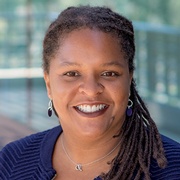May the 4th: Star Wars and the Evolution of Diversity and Inclusion
By Vignetta Charles, PhD | May 4, 2021
Chief Executive Officer, ETR
It was a lazy Sunday, and we were watching Star Wars: The Empire Strikes Back. My 10-year-old, like every other kid his age, is always looking to see themselves represented in the content we consume. He turned to me and asked, “Why aren’t there that many diverse people in this Star Wars movie?” Me, his GenX mom, started talking about my love of Lando Calrissian and what he represented. Then, I paused and realized that within the entire franchise, my son’s favorite Star Wars movie is The Rise of Skywalker (the most recently released movie) and he particularly loves the Star Wars comic books.
Within his favorites, there is far more diversity amongst the characters (humans and other species) represented in all ways—race, sexual orientation, and gender identity. Although the Star Wars franchise has always had some diversity, it has only been slowly over time that main characters like Finn and Rose have started to reflect the evolution of our times and the demand for more and better representation of our world. For example, the newest cover of the latest comic book series celebrates two trans non-binary characters.
From that simple question, I began to realize that a franchise I viewed as so inclusive when I was young now would receive some mixed ratings for human diversity. When I was 10, I loved seeing Princess Leia as a fierce fighter instead of a damsel in distress, and I reveled in the complexity of Lando’s character as key player and hero rather than a comic relief side character (which is how so many Black characters were relegated at the time). These were transformative when I was young--and were vanguard at that time.
But compared to the modern Star Wars sagas that my son consumes, these original films no longer seem very inclusive. My son needed me to say more than just expressions of my love for Lando in response to his question. So I replied, “Yes, there isn’t as much diversity in the first Star Wars movies as compared to what you watch and read today. But they definitely got more inclusive over time and seem to keep striving to get better. I guess that’s what we’re all working toward—learning from our past and moving forward knowing and doing better.” He was satisfied with this answer and could enjoy the rest of the movie while recognizing its complicated context.
ETR is no different than Lucasfilm in this way. We have our struggles with diversity, inclusion, and belonging. Like most organizations, we have a complicated past. But we are not shying away.
Instead, we are learning and naming and moving forward to do better. It’s hard work—but it’s essential that our services, products, policies, and processes reflect the values of the world we want to live in. We envision a world, and an ETR, that embraces the purposeful inclusion of all people in mission of honoring and respecting difference as well as elevating the strengths brought by diversity of experience, perspective, and expertise.
Hopefully today, and all future days, our team and partners will continue to see and experience our ongoing evolution to live our values of inclusivity in all the ways we show up.
Vignetta Charles, PhD, (she/her/hers) is Chief Executive Officer of ETR. Dr. Charles can be reached at vignetta.charles@etr.org.





